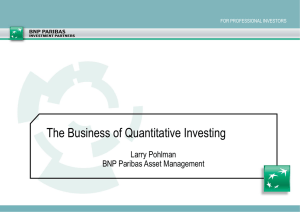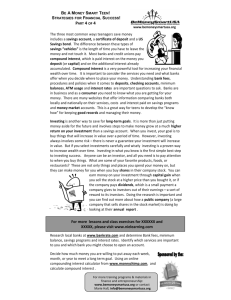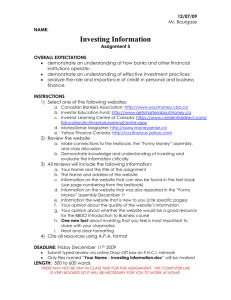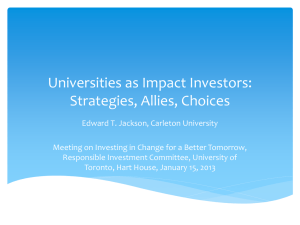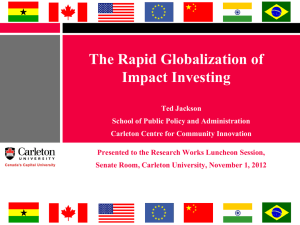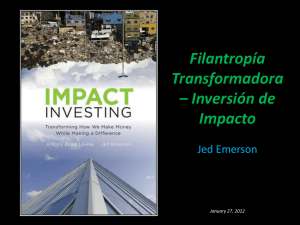Where Do Impact Investing and Microfinance Meet?
advertisement
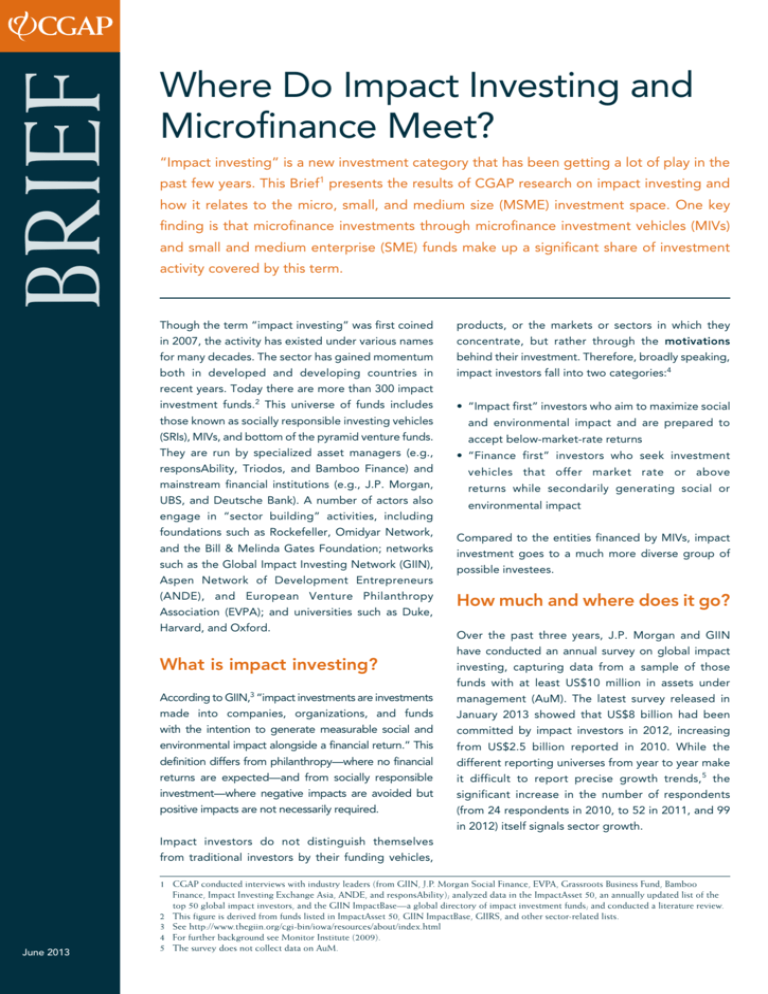
BRIEF Where Do Impact Investing and Microfinance Meet? “Impact investing” is a new investment category that has been getting a lot of play in the past few years. This Brief1 presents the results of CGAP research on impact investing and how it relates to the micro, small, and medium size (MSME) investment space. One key finding is that microfinance investments through microfinance investment vehicles (MIVs) and small and medium enterprise (SME) funds make up a significant share of investment activity covered by this term. Though the term “impact investing” was first coined in 2007, the activity has existed under various names for many decades. The sector has gained momentum both in developed and developing countries in recent years. Today there are more than 300 impact investment funds.2 This universe of funds includes those known as socially responsible investing vehicles (SRIs), MIVs, and bottom of the pyramid venture funds. They are run by specialized asset managers (e.g., responsAbility, Triodos, and Bamboo Finance) and mainstream financial institutions (e.g., J.P. Morgan, UBS, and Deutsche Bank). A number of actors also engage in “sector building” activities, including foundations such as Rockefeller, Omidyar Network, and the Bill & Melinda Gates Foundation; networks such as the Global Impact Investing Network (GIIN), Aspen Network of Development Entrepreneurs (ANDE), and European Venture Philanthropy Association (EVPA); and universities such as Duke, Harvard, and Oxford. What is impact investing? According to GIIN,3 “impact investments are investments made into companies, organizations, and funds with the intention to generate measurable social and environmental impact alongside a financial return.” This definition differs from philanthropy—where no financial returns are expected—and from socially responsible investment—where negative impacts are avoided but positive impacts are not necessarily required. products, or the markets or sectors in which they concentrate, but rather through the motivations behind their investment. Therefore, broadly speaking, impact investors fall into two categories:4 • “Impact first” investors who aim to maximize social and environmental impact and are prepared to accept below-market-rate returns • “Finance first” investors who seek investment vehicles that offer market rate or above returns while secondarily generating social or environmental impact Compared to the entities financed by MIVs, impact investment goes to a much more diverse group of possible investees. How much and where does it go? Over the past three years, J.P. Morgan and GIIN have conducted an annual survey on global impact investing, capturing data from a sample of those funds with at least US$10 million in assets under management (AuM). The latest survey released in January 2013 showed that US$8 billion had been committed by impact investors in 2012, increasing from US$2.5 billion reported in 2010. While the different reporting universes from year to year make it difficult to report precise growth trends, 5 the significant increase in the number of respondents (from 24 respondents in 2010, to 52 in 2011, and 99 in 2012) itself signals sector growth. Impact investors do not distinguish themselves from traditional investors by their funding vehicles, June 2013 1 CGAP conducted interviews with industry leaders (from GIIN, J.P. Morgan Social Finance, EVPA, Grassroots Business Fund, Bamboo Finance, Impact Investing Exchange Asia, ANDE, and responsAbility); analyzed data in the ImpactAsset 50, an annually updated list of the top 50 global impact investors, and the GIIN ImpactBase—a global directory of impact investment funds; and conducted a literature review. 2 This figure is derived from funds listed in ImpactAsset 50, GIIN ImpactBase, GIIRS, and other sector-related lists. 3 See http://www.thegiin.org/cgi-bin/iowa/resources/about/index.html 4 For further background see Monitor Institute (2009). 5 The survey does not collect data on AuM. 2 Table 1. Impact investing sector allocations Sector AuM % of AuM Microfinance 6,400,000,000 72.1 SME finance 1,300,000,000 14.6 Agriculture 585,000,000 6.6 Housing 100,000,000 1.1 Education 17,000,000 0.2 Environment 216,000,000 2.4 Cross-sector 263,000,000 3.0 Total 8,881,000,000 100 The J.P. Morgan–GIIN reports cover both developed and developing markets. To assess the scale of impact investing focused on developing countries, CGAP analyzed the ImpactAsset 50 and GIIN ImpactBase databases and found that the top 50 impact investing funds active in developing countries have just over US$8.6 billion in AuM as of December 2011. Table 1 summarizes the various sectors covered by the impact investing space in developing countries and their relative scale, using the following typology.6 Microfinance makes up close to three-fourths of total impact investing AuM (US$6.4 billion) focused on developing countries. SME finance follows, with a 14.6 percent (US$1.3 billion) share. Agriculture AuM are one-tenth of microfinance assets; other sectors are still more nascent. Interestingly, over 70 percent of the sampled funds (based on AuM) are expecting near-to-market rate of returns. While MSME-related investments represent the vast majority of impact investing exposure thus far, this is likely to change soon with the observed trend to launch funds and facilities focused on the agribusiness and fair-trade sectors. For example, in September 2011, four members of GIIN’s Investors’ Council (J.P. Morgan and the Bill & Melinda Gates, Gatsby Charitable, and Rockefeller Foundations) closed a US$25 million impact investment into the African Agricultural Capital Fund, managed by Pearl Capital Partners, which primarily invests in small and medium-sized agricultural enterprises to improve the livelihoods of smallholder farmers in East Africa. The U.S. Agency for International Development (USAID) provided a 50 percent debt guarantee to J.P. Morgan’s investment, as well as a grant-funded technical assistance facility for the fund’s investees. Several specialized asset managers, such as responsAbility and Incofin, with track records in microfinance, are also launching “fair-trade” funds with a special focus on Latin America (coffee) and Africa (cocoa), each estimated at around US$50 million. Other sectors with smaller exposures that are attracting attention include education, water, and health. The impact investing community is most active in sub-Saharan Africa (SSA).7 Investment firms such as Invested Development, Grassroots Business Fund, Acumen Fund, and Village Capital, among others, have recently set up offices in East Africa.8 “Financefirst” investments in the region are made primarily by private equity and venture capital funds, while “impact-first” investors, such as development finance institutions, private foundations, and specialized asset managers, provide the main funding for early growthstage companies. Who’s funding this? Funding for impact investing comes from a variety of sources. Public investors and donors are the main sources, while about one-third of the assets are raised from institutional investors and private individuals. 6 For more information see O’Donohoe et al. (2010). 7 Microfinance investments in SSA grew by 12 percent annually on average to reach close to US$2.7 billion, while SSA’s MIV portfolio has been the fastest growing (CGAP 2012 Funder Survey and Symbiotics 2012 MIV Survey). 8 For additional information on Africa, see Glisovic and Mesfin (2012). 3 Donors and public investors, who see impact investing as an opportunity to leverage private investment into solving development goals (particularly as aid budgets are under pressure), are the main actors supporting high-risk investments and early-stage businesses. Examples include USAID’s development innovation ventures, the World Bank’s development marketplace, and the Inter-American Development Bank Multi-lateral Investment Fund’s Opportunity for the Majority Initiative. Improvements in impact investing infrastructure could enable more “brokering” between funds and social enterprises. For example, the Nexus for Impact Investing in South Africa, the South Africa Social Investment Exchange, and the Impact Investment Exchange Asia (IIX) platforms seek to match investor capital with impact ventures. Key supporters of the development of social capital markets include the Rockefeller Foundation and some regional development banks, such as the Asian Development Bank. Outlook and challenges Interest in impact investing has grown in the past three years, resulting in increased assets and improved sector infrastructure. However, several important challenges need attention. First, information on the financial and social performance of impact investments is either scarce or unavailable. While the Global Impact Investing Rating System (GIIRS) and Impact Reporting and Investment Standards have focused on standardizing impact measurement, there are still widely divergent practices in whether and how impact investors systematically track social impact. Establishing standard performance metrics and making this information publically available through platforms such as the Microfinance Information Exchange (www. mixmarket.org) were instrumental in advancing the microfinance industry, allowing financial and social benchmarking across regions and institutions. Efforts such as the “Microfinance Investment Vehicles Disclosure Guidelines” (CGAP 2010) to codify standard indicators and ratios strengthened reporting by microfinance investment managers. Donors can speed the evolution of the impact investment industry by learning from these experiences. Donor support to develop standardized financial and social performance metrics for impact investments can enhance transparency and allow benchmarking on fund performance. A second concern for the impact investing industry is whether the social impact expectations created by the growing excitement around impact investing can be met. Some newer entrants to the market may overestimate the current market potential and anticipate unrealistic development returns. Lessons from microfinance, which faced a similar challenge of inflated expectations, might be relevant. Alignment of the message about the impact investing sector’s financial and social returns with the actual evidence (ideally against standardized metrics) may help allow the industry to mature at a realistic and sustainable pace. The final challenge concerns capacity. MIVs were created after many years of direct investment in and capacity building of microfinance institutions (MFIs). Only once a robust number of MFIs were in place did the microfinance investment community emerge. Impact investing seems to be missing this important phase of “pipeline creation” with donors and investors jumping directly into the investment vehicle phase. Donors may need to help build a pipeline of “investment ready” firms to narrow the gap between investors’ appetite and absorption capacity. Incubators are one vehicle to help nurture investmentready social enterprises. Additional funding and support is needed to support the capacity-building infrastructure for the nonmicrofinance segments of the impact investing sector. References CGAP. 2010. “Microfinance Investment Vehicles Disclosure Guidelines.” Consensus Guidelines. Washington, D.C.: CGAP. Glisovic, Jasmina, and Senayit Mesfin. 2012. “Microfinance Investments in Sub-Saharan Africa.” Brief. Washington, D.C.: CGAP, June. Monitor Institute. 2009. “Investing for Social and Environmental Impact: A Design for Catalyzing an Emerging Industry.” San Francisco: Monitor Deloitte. June 2013 O’Donohoe, Nick, Christina Leijonhufvud, Yasemin Saltuk, Antony Bugg-Levine, and Margo Brandenburg. 2010. “Impact Investments: An Emerging Asset Class.” Washington, D.C.: J.P. Morgan Chase & Co., The Rockefeller Foundation, and Global Impact Investing Network, Inc. All CGAP publications are available on the CGAP Web site at www.cgap.org. CGAP 1818 H Street, NW MSN P3-300 Washington, DC 20433 USA Tel: 202-473-9594 Fax: 202-522-3744 Email: cgap@worldbank.org © CGAP, 2013 AUTHORS: Mayada El-Zoghbi and Henry Gonzalez
